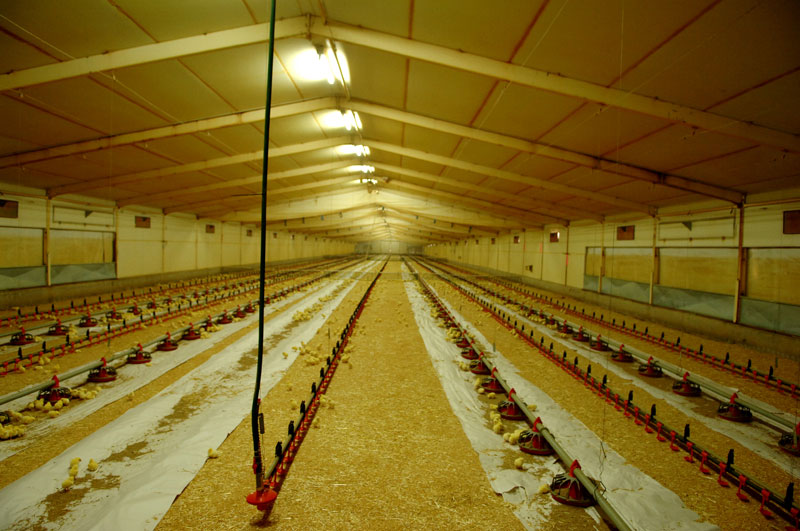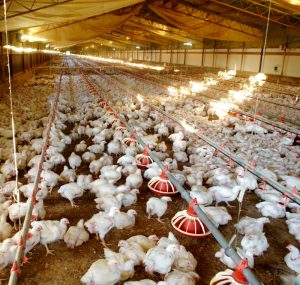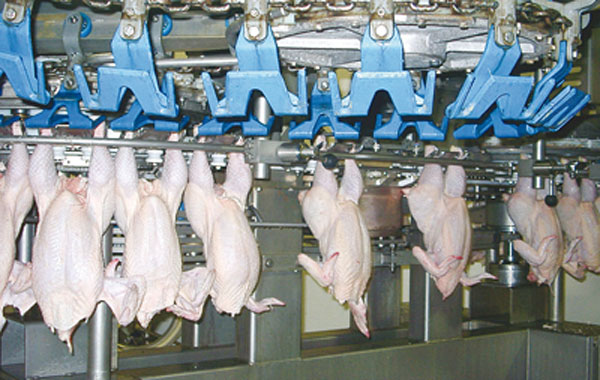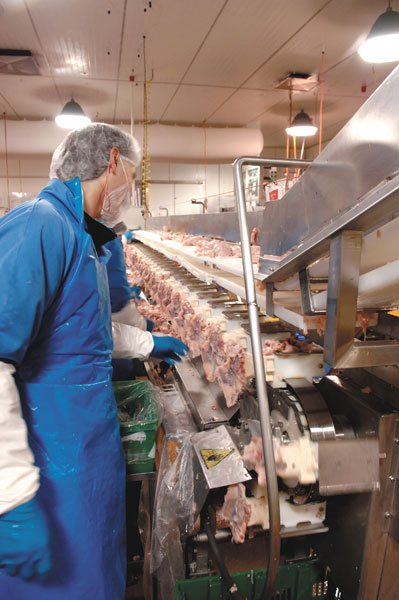Meat chicken farm sequence
Meat chicken farm sequence
The same general principles of caring for layer chickens also apply on a meat chicken farm but there are few differences. Meat chickens are always fed pelleted feed, which is more efficient as less wastage occurs than when mash is used. Pelleting also improves the digestibility of the feed. The pellets may be broken down into smaller sizes, called crumbles, for very small chicks.

Broiler chicks on litter
Hatchery to farm
Newly hatched chicks are transported to broiler farms, in ventilated chick boxes, in air-conditioned trucks that are specifically designed to carry chicks. It is important that chicks receive feed, water and warmth soon after hatching, however, the remains of the yolk sac can sustain each chick for up to 72 hours post-hatch.
Brooding or Starting phase
On arrival at the broiler farm, day-old chicks are placed onto the floor of the shed, where they are initially confined to an area of between a half to one-third of the total shed area (the ‘brooding area’) and given supplementary heating from gas heaters or heat lamps (referred to as brooders) for about three weeks. This period of time is called brooding. Extra feed pans and water dispensers are provided in the brooding area, and the bedding may be partly covered with paper to stop dropped feed from getting into the bedding and spoiling. Both male and female chicks are reared as meat chickens. While the flocks are usually of mixed-sex, some operations may grow male and female chickens separately, depending on market requirements. For example, one company grows out only male chickens in one area, allowing its operations and processing plant in that area to be geared up specifically for larger birds while sending female chicks to another area.
The air temperature under the brooder should initially be 35 – 34oC and reduced by 1-2oC per day until it reaches 23oC when the chickens are approximately three weeks of age, and then kept constant till the end of the production period. Sophisticated brooding systems have been developed which include gas-fired radiant heat sources, through gas-fired hot air blasters, and fully controlled environment sheds with special heated air passed through ducts to the chickens. High amino acid density diets are fed to young meat chickens to ensure they grow as much as possible early in life, as early growth rate and weight gain influence the flock performance at later stages. A medicine, called a coccidiostat, is added to the feed of meat chickens to prevent them from intestinal coccidiosis. In-feed antibiotics may be added to promote growth and performance and prevent the birds from enteric diseases. Alternatives to in-feed antibiotics such as probiotics, prebiotics, organic acids, essential oils and/or some medicinal plants derivatives may also be added to meat chicken diets. Australian meat chickens are raised on litter floors, but some overseas companies use wire-floored cage systems. The number of chickens in a meat chicken shed is usually high, with some Australian sheds containing up to 30,000 meat chickens. Newly designed sheds can accommodate up to 50,000 birds per shed, provided a good and even ventilation, heating and cooling systems are assured.
Growing or Finishing phase

At this phase, growth is still very important, but since feed is expensive careful costing is carried out to keep expenses to a minimum. Thus, a low amino acid density diet is fed to the chickens for the remainder of their life (usually until 42 days of age). Heavyweight birds that are required for chicken fillets are slaughtered at up to 56 days of age. A coccidiostat, sometimes a different one from that used in starter feed, is added to the finisher feed. Some meat chickens go through a separate rearing stage, with a special rearing ration (grower) being fed to them before they are placed on a finisher feed, but most go straight from starter to finisher feed.
Harvesting phase
Getting finished meat chickens from the farm to the factory is a delicate business. Most catching is done at night when the birds are quieter, and this also gets them to the processor early in the morning with less delay before slaughter. Delays can result in stress and weight loss. Mechanical devices for harvesting meat chickens have been invented, however, results are variable and most Australian meat chickens are still caught by hand. Birds are placed into plastic crates or aluminium modules designed for good ventilation and safety from bruising during transport. These crates or modules are handled by specialist forklift equipment and loaded onto trucks for transport to the processing plant. In Australia, a percentage of chickens are harvested at up to four different times depending on the need for light or heavy birds. Harvesting is also known as ‘partial depopulation’, ‘thinning out’, or ‘multiple pick-up’. Thinning out sheds allows more space for the remaining birds and reduces the natural temperature in the shed. The first harvest can occur as early as 30-35 days of age and the last harvest at 55-60 days of age.
Shed clean-out
Once all the birds have been harvested (after approximately 60 days), the shed is cleaned and prepared for the next batch of day-old chicks, which generally arrives five days to two weeks after the previous harvest. Not only this time between batches is used to clean the shed, but it also reduces the risk of common ailments being passed between batches as many pathogens die off in this time. Many farms undertake a full clean-out after every batch. This involves removing bedding, brushing floors, scrubbing feed pans, cleaning out water lines, scrubbing fan blades and other equipment, and checking rodent stations. High-pressure hoses clean the whole shed thoroughly. The floor bases are usually rammed earth and because low water volumes are used, there is little water runoff.
Once the shed has been thoroughly cleaned, it is disinfected. This is carried out using low volumes of disinfectant sprayed throughout the shed. If insects, such as beetles, were a problem in the previous batch an insecticidal treatment may also be used. Any disinfectant or insecticide that is used must be approved by the Australian Pesticide and Veterinary Medicines Authority (APVMA) as safe and fit for use in broiler sheds. After a full clean-out, company veterinarians or servicemen will test the shed to confirm that it has been adequately cleaned and any potential disease agents removed. Sometimes, a partial shed clean-out only is required which involves removing old litter and/or topping up fresh litter and cleaning and sanitising equipment. However, a full clean-out is done after every second or third batch of chickens.

Processing line
Processing
When chickens arrive at the processor they go through the following sequence:
- Hung by the legs on a shackle
- Stunned using an electrically charged water bath
- Killed by cutting the blood vessels in the neck
- Bled so that most of the blood leaves the carcass
- Scalded to soften the attachment of the feathers
- Plucked to remove the feathers
- Head removed
- Gutted or eviscerated to remove the internal organs
- Washed to remove blood and soiling from the carcass
- The hock is cut to remove the feet
- Chilled to prevent bacterial spoiling
- Drained to remove excess water from the carcass
- Weighed
- Cut selection to divide the carcass into the desired portions (breast, drumsticks etc.)
- Packed in plastic bags to protect carcasses or portions
- Chilled or frozen for storage
The carcasses are graded during the processing sequence to remove poor quality meat. This meat is used for cut-up (further processing) purposes or, if badly affected, might be used for pet food or condemned and cooked to be made into meat meal for stock feed.

Removal of breast meat
Further Processing and storage
Further processing includes cutting up the carcasses into portions, deboning carcasses and preparing special ready-to-cook products. Cooking is an additional process which is carried out at some processing plants. Almost all chicken meat is sold chilled. Chilled chicken meat must be cooked before it spoils. The shelf life of chicken meat is usually 8 to 12 days, depending on the processing, handling and storage conditions.
Marketing
In Australia, most chickens are sold under a brand name and market competition is very strong. The per capita consumption of chicken meat has increased gradually in Australia over the past decades. According to the data presented by Australian Bureau of Statistics (ABS) and Australian Bureau of Agricultural and Resource Economics and Sciences (ABARES), the figure has doubled since the 1980s and reached 46.2kg/person in 2015-16.
External links
Visit the Australian Chicken Meat Federation for more information on the Broiler Industry.

